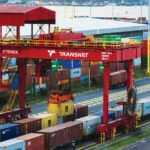Heightened risks for shipping post-pandemic
Heightened risks for shipping post-pandemic
While the Covid-19 pandemic resulted in few direct claims for the marine insurance sector, a boom in shipping, an ageing fleet, and vessels being used for operations other than their intended purpose are all issues raising potential safety concerns.
Seafarers were the unsung heroes of the pandemic, keeping the world supplied with food, energy, raw materials, and manufactured goods. Yet Covid-19 and now Russia’s invasion of Ukraine have taken their toll on the industry’s workforce.
Covid-19 restrictions and travel bans meant hundreds of thousands of crew members were left stranded on ships, some for more than a year. At the peak of the pandemic in 2020, it was thought that up to 400 000 seafarers were unable to be repatriated, a number that halved in 2021, according to a statement by Kitack Lim, secretary-general of the International Maritime Organization.
The Covid-19 crew crisis is now largely over, but the experience is likely to have long-lasting effects. “The health and well-being of crew have always been a critical factor in safety,” says Captain Rahul Khanna, global head of marine risk consulting at Allianz Global Corporate and Specialty (AGCS). “However, morale among seafarers is currently low and the pandemic has had an impact on the mental health and well-being of crew. Now crews face a rising workload, while the ever-growing burden of compliance is making the job less attractive.”
In what has been termed the “great resignation”, the pandemic prompted many workers to rethink their work-life balance, with some choosing to retire or switch careers. The combination of the pandemic and current working conditions risks a future skills shortage for the shipping industry, according to Captain Nitin Chopra, a senior marine risk consultant at AGCS.
“During the pandemic, hundreds of thousands of seafarers were unable to leave their vessels or see their families for a prolonged period. What they have endured will have a lasting impact, and it is likely many seafarers will not return. Ship owners in some segments could feel the pinch. We do not want to see dispensations or special considerations being given by flag states,” says Chopra.
During March and April 2022, a number of vessels owned by ferry operator P&O Ferries were detained by UK authorities over safety concerns, including crew familiarisation and training. The operator had previously made over 800 crew redundant and replaced them with lower-paid workers.
Crew welfare and retention rate is a risk factor considered in underwriting, explains Justus Heinrich, global product leader of marine hull at AGCS. “Our major clients have crew retention programmes and we see a lot of investment in attracting and retaining crew, as well as welfare management,” he notes. “From the perspective of our risk assessment, we like to see high levels of crew retention and evidence of good people risk management. Particularly with more modern vessels and technology, the ability to attract and retain experienced crew is critical.”
Russia’s invasion of Ukraine has further ramifications for a global maritime workforce already facing shortages. Russian seafarers account for just over 10% of the world’s 1.89 million seafarers, while around 4% are from Ukraine, as pointed out by the International Chamber of Shipping (ICS) and the shipping trade association BIMCO in their Seafarer Workforce Report.
With many direct flights to Russia suspended, and with fewer vessels calling at Russian and Ukrainian ports, seafarers from these countries may struggle to return home or rejoin ships at the end of their current contracts. Ultimately, seafarers on the Black Sea are in a perilous situation, stuck onboard vessels or in ports with dwindling supplies that may even be under fire – yet another blow for the industry and for global supply chains, given that crew levels have not yet returned to normal.
Regular crew changes are required across the world to ensure that workforce flow is maintained. The Seafarer Workforce Report warns that there could be a “serious shortage” of officers within the next four years if action is not taken to increase training and recruitment levels. The report predicts that there will be a need for an additional 89 510 officers by 2026, yet there was already a shortfall of 26 240 certified officers last year.
Higher values, conversions, and older vessels increase exposures
The economic rebound from Covid-19 lockdowns has created a boom time for shipping, with huge increases in charter and freight rates. While higher rates are financially positive for many in the industry, changing the use of vessels to take advantage of this and extending the working life of ships both raise warning flags for underwriters.
High demand for container and bulk shipping has seen the value of vessels rise dramatically, while charter and freight rates have skyrocketed. Charter rates in the container and LNG markets hit an all-time high last year, and a decade high in the dry bulk market, while values remain well above historical averages, says VesselsValue, which has been providing data and analysis for the maritime and aviation markets since 2011.
The company highlights that the value of a five-year-old Panamax boxship more than tripled between January 2020 and January 2021 – from US$22 million to US$82 million. Charter rates for a Panamax have increased by 274% over the same period. Last year also saw record values for bulkers, with a five-year-old Supramax increasing in price by 46%, from US$19 million to US$27 million.
“Rising values and charter rates have created a mismatch for insurers,” explains Captain Anastasios Leonburg, senior marine risk consultant at AGCS. “Older vessels now command higher values, while the accumulation risks have increased, with larger vessels and more value on board. This results in a significant increase in the risk profile, which is not necessarily reflected in premiums.”
At the same time, the impact of inflation results in rising claims costs, adding to this challenging environment. Higher freight rates and a shortage of container ship capacity have tempted some operators to use bulk and product carriers to transport containers. It has also led some tanker operators to explore the possibility of converting their vessels. Swedish tanker shipping company Concordia Maritime and ship designer Stena Teknik, for example, have announced a feasibility study into converting tankers into container vessels.
The use of non-container vessels to carry containers, however, can raise questions about stability, firefighting, and the securing of cargo, says Chopra: “Bulk carriers and tankers are not designed to carry containers. Crews may not be trained or experienced enough to handle containers or respond appropriately to an incident at sea. Carrying containers could also change the manoeuvring characteristics of a vessel and affect how it behaves in bad weather and strong winds. Converting a vessel or changing its use would likely be viewed as a material change in risk profile and could be categorised by underwriters as a higher risk.”
With demand for shipping high, owners are also extending the working life of vessels. Even before the pandemic, the average age of vessels in the global merchant fleet was rising. According to the International Union of Marine Insurance Stats Report 2021, these vessels averaged around 19 years a decade ago, or 13 years for vessels greater than 2 000 gross tonnage (GT). In 2021, this had risen to 21.75 years, or 14.7 years for vessels greater than 2 000 GT.
Analysis has shown that older container and cargo vessels of between 15 and 25 years of age are more likely to result in a claim. “Newer ships need less maintenance and have the latest technology, which typically translates to a lower risk,” notes Heinrich. “Older ships are more likely to suffer from corrosion, while systems and machinery are more prone to failure and breakdown. Of course, that is not to say we don’t also see well-managed and maintained fleets composed of older vessels as well.”
So, the current uncertainty might not lead to a rise in claims from the marine insurance sector, but the post-pandemic world definitely holds heightened risks for the shipping sector.
Published by
Focus on Transport
focusmagsa




